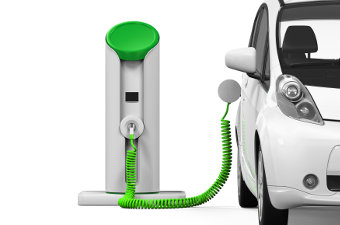Electric Vehicle Charging Stations
Last Updated: 11/20/24
An electric vehicle charging station, also called EV charging station, electric recharging point, charging point, charge point and EVSE (electric vehicle supply equipment), is an element in an infrastructure that supplies electric energy for the recharging of electric vehicles, such as plug-in electric vehicles, including electric cars, neighborhood electric vehicles and plug-in hybrids.
 Product Details
Product Details
To the maximum extent practicable, federal agencies are required to buy sustainable products, which are products that meet the purchasing program(s) listed below.
If there is more than one program listed below, agencies are directed to prioritize multi-attribute products, which meet statutory purchasing program requirements (![]() ) and one or more required Environmental Protection Agency purchasing programs.
) and one or more required Environmental Protection Agency purchasing programs.
Review our frequently asked questions for more information.
|
Procurement Info
|
Where to Buy
|
|---|---|
 Legal Requirements
Lists federal requirements related to the purchase of this item, including applicable Federal Acquisition Regulation (FAR) requirements
Legal Requirements
Lists federal requirements related to the purchase of this item, including applicable Federal Acquisition Regulation (FAR) requirements
 Life Cycle Cost Savings
Life Cycle Cost Savings
Life Cycle Costing (LCC) aims to quantify the financial impact of a product over its entire life cycle to assist consumers in making decisions that will save them money over the long term.
An efficient product is cost effective when the utility costs saved over the life of the product exceed the additional upfront cost (if any) of the more efficient model. Energy Star considers both upfront costs and lifetime energy cost savings when setting required efficiency levels. Federal purchasers can assume that Energy Star-qualified products are life-cycle cost effective.
 Guiding Principles
Guiding Principles
Contributes to meeting The Guiding Principles for Sustainable Federal Buildings
 Additional Guidance
Additional Guidance
On December 27, 2016, the Environmental Protection Agency (EPA) finalized its first-ever ENERGY STAR specification for electric vehicle chargers. Electric vehicle charging infrastructure in the home and in the public sphere is increasing rapidly; the ENERGY STAR label will help consumers, utilities, manufacturers and others integral to developing electric vehicle charging infrastructure identify more energy efficient products in this fast-growing industry.
On June 15, 2016, the Office of Federal Sustainability announced the availability of the "Guidance for Federal Agency Implementation of Workplace Charging Pursuant to the Fixing America’s Surface Transportation (FAST) Act: Level 1 Charging Receptacles"![]() . This guidance applies only to Federal agency buildings not under the jurisdiction, custody, or control of the General Services Administration.
. This guidance applies only to Federal agency buildings not under the jurisdiction, custody, or control of the General Services Administration.
On October 19, 2016, the Office of Federal Sustainability announced the availability of the "Guidance for Federal Agency Implementation of Workplace Charging Pursuant to the Fixing America’s Surface Transportation (FAST) Act: Electric Vehicle Supply Equipment"![]() . This guidance applies only to Federal agency buildings not under the jurisdiction, custody, or control of the General Services Administration.
. This guidance applies only to Federal agency buildings not under the jurisdiction, custody, or control of the General Services Administration.
Data – When going out to purchase stations, Level 2 stations (208-240V) are capable of capturing charging data, which is a requirement for the Federal Automotive Statistical Tool.
Types of Charging Stations – There are three different levels of charging – Level 1, Level 2, and Level 3.
- Level 1 charging is the slowest charging option and provides about 5 miles of range for every hour of charging. It utilizes a 110-120 volt wall outlet and takes approximately 7-12 hours to deliver a full charge to an electric vehicle. While there are some Level 1 charging stations commercially available, typically Level 1 charging utilizes the vehicle’s standard charging cord and a standard power outlet.
- Level 2 charging is the most common form of elective vehicle station equipment and can provide 10-20 miles of range for every hour of charging. It uses a 208-240 volt electrical connection and can typically charge an electric vehicle in 2-5 hours. Level 2 charging stations often come with options for data network accessibility that allows you to track kilowatt hours used, length of charging sessions, etc. Level 2 stations come in a variety of options, including:
- Wall, Pole, or Bollard Mounting
- Single or Dual Port (dual ports allow two vehicles to be charged at the same time)
- Cellular vs. Ethernet data reporting
- Level 3 charging is also commonly referred to as DC Fast Charging and can provide up to 40 miles of range for every 10 minutes of charging. It is the quickest, and most expensive, electrical vehicle charging equipment available on the market. It can fully charge an electric vehicle battery in 30 minutes or less.
Site Planning and Installation – Before making a charging station purchase, it is important for the location to do proper site planning. The agency fleet manager, building manager, charging station vendor, and building leasing company (if applicable) should consult before any equipment is purchased. Installations can cost as much as, or more than, the station equipment depending on where each station is located and the building infrastructure that exists. Installation can be completed by the facilities on site, or through a contracted installer and electrician. The installer will be able to tell you how costly installation may be depending on the location and ensure your station is up to all electrical codes and safety standards. Installation costs rise as the distance to the power source increases.
Credit Card Acceptance: Charging Station procurement for use by vehicles other than government-owned electric vehicles, such as employee or visitor vehicles, will be required to have a pricing policy of some kind in accordance with Section 1413(c) of the FAST Act.


 Energy Star
Energy Star